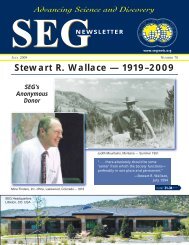Download - Society of Economic Geologists
Download - Society of Economic Geologists
Download - Society of Economic Geologists
Create successful ePaper yourself
Turn your PDF publications into a flip-book with our unique Google optimized e-Paper software.
10 SEG NEWSLETTER No 65 • APRIL 2006... from 9The Mineral Exploration Business: Innovation Required (Continued)determine how well they are doing(Loch and Tapper, 2001). This can alsobe said for E&D. It is interesting to notethat Loch and Tapper (2001, p. 459)state that “evaluating results by financialcriteria has not provided ananswer. In fact, companies using ONLYfinancial measures in R&D fundingdecisions perform worse than thoseusing qualitative criteria.” This findingcan be related to the fact that in E&Dthe effort is not directly observable, andthere is great uncertainty about discovery:at what point is it certain that youhave discovered an orebody? The incentiveto invest in what mining companymanagement perceive as risky is low,especially if management cannot“own” the benefits. For example, inlarge corporations, a discovery may notbe credited back to the managementthat discovered it.The best means <strong>of</strong> measuring successin R&D/E&D for any company is byusing the notion <strong>of</strong> benchmarking,which implies that being at least asgood as the market leader is a prerequisitefor being competitive. The first stepis to keep careful track <strong>of</strong> one’s own andthe competitors´ performance, lookingespecially for unexpected success or forunexpected poor performance, particularlyin areas where one should havedone well. The successes demonstratewhat the market values and will pay for(Drucker, 1999)—they indicate wherethe business enjoys a leadership advantage.The failures should be viewed asthe first indication that either the marketis changing or the company’s competenciesare weakening.The market for the exploration businessis the major mining houses. Nonsuccessin terms <strong>of</strong> lack <strong>of</strong> discovery orproduct will ultimately cause an E&Dcompany to die because it will not beable to secure funding, either from themarket or major mining houses. Yet inmajor company exploration departmentsthis urgency rarely exists. If anE&D company is successful in discoverybut the market does not want the producton the basis <strong>of</strong> size, location, orwhatever, then the company mightconsider the option <strong>of</strong> developing theproduct on its own. However, thischoice will likely be decided by theresource banking sector: does it considerthe deposit worthy <strong>of</strong> funding? Ofcourse, as soon as a company goes fromE&D to mining, it immediately faces thesame questions as a major mining companywith regards to exploration andthe role <strong>of</strong> this activity within the company.What level <strong>of</strong> pr<strong>of</strong>its does one putback into exploration to balance riskversus opportunity versus growth?The message is therefore “perform ordie.” Exploration companies must innovateif they are to compete and be successful.Innovation is the specific instrument<strong>of</strong> entrepreneurship. It is the actthat endows resources with a newcapacity to create wealth (Drucker,1985). All survivors in this new businessera, whether individuals or corporations,must adopt an entrepreneurialmind-set (Snow and Juhas, 2002, p. 14).Entrepreneurial entities thrive on innovation;however, most <strong>of</strong> the innovationis not in high technology, but ratherincremental improvements in productquality, more flexible managementapproaches, better marketing concepts,and better service to customers(Drucker, 1985). What can explorationcompanies do to embrace innovation?It is appropriate at this point to examinehow R&D is viewed in other businesssectors.THE BUSINESS OFEXPLORATION:COMPARISON WITH R&DWe have compared the R&D process asdefined by Nellore (2001) with theprocess <strong>of</strong> E&D in Table 1: the similaritiesare clear. The R&D process withinthe pharmaceutical industry provides agood comparison <strong>of</strong> risk and opportunitywith that <strong>of</strong> the exploration andmining business.The stages, timing, and risksinvolved in the drug development process(Table 2) are remarkably similarto the mineral exploration process. Asdescribed by one <strong>of</strong> the major pharmaceuticalcompanies, GlaxoSmithKline,“It is getting more difficult and takinglonger—currently an average <strong>of</strong> 12years—to develop new medicines.Despite a substantial increase in globalR&D expenditure, fewer novelmedicines were launched in 2003 thanat any time during the last 20 years.”(Glaxo SmithKline, 2005, p. ii). Theycontinue, “It takes well over £500 million[US$900 million] and between 10and 12 years to develop a new drug.For every million compounds screened,approximately 250 make it to pre-clinicaltesting, 10 advance to clinical trialsand just one is approved for patientuse.” (GlaxoSmithKline, 2005, p. 6).This sounds very similar to the mineralextraction industry, and is somethingthat needs to be explained to theinvestment market. Another comparison<strong>of</strong> risk is shown in Figure 2, from astudy by the Industrial ResearchInstitute <strong>of</strong> Washington, D.C. (1999),which looks at the ideas that succeedin all industries. A success rate <strong>of</strong> 1 in3,000 to 5,000 compares well with that<strong>of</strong>ten quoted for exploration projects (1in 1,000). The point to make here isthat while exploration is a high-riskTABLE 1. The Similarity <strong>of</strong> the Research and Development (R&D) Process <strong>of</strong> Industries inGeneral (Nellore, 2001) with the Exploration and Discovery (E&D) Process <strong>of</strong> the MiningIndustryThe R&D ProcessLong-Range ResearchGeneral scientific/technology researchunrelated to any specific productAdvanced Product EngineeringResearch and development focusingon product linesProduct EngineeringAdapting the product concepts foruse in productsThe E&D ProcessGrass-roots explorationGeneral exploration <strong>of</strong> country or region;target generation explorationAdvanced ExplorationExploration and discovery focusing onquality economic orebodies incorporatinggeology, mine engineering, metallurgyand economics focusing on the productMine Engineering, Mineral processingand Geological ModellingPreparing the product – reserves formining and the market






